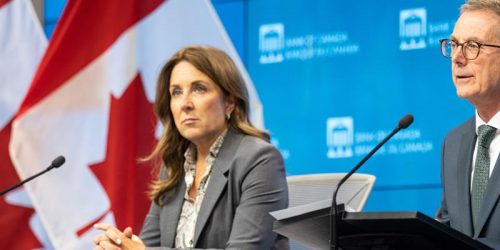Monetary Policy Decision Press Conference Opening Statement
Good morning. I’m pleased to be here with Senior Deputy Governor Carolyn Rogers to discuss today’s policy announcement.
Governing Council decided monetary policy no longer needs to be as restrictive and lowered the policy interest rate by 25 basis points to 4.75%.
We’ve come a long way in the fight against inflation. And our confidence that inflation will continue to move closer to the 2% target has increased over recent months. The considerable progress we’ve made to restore price stability is welcome news for Canadians.
Since our Monetary Policy Report in April, underlying inflation has continued to ease and economic growth has resumed. With the economy in excess supply, there is room for growth even as inflation continues to recede.
Let me provide a little more detail about these dynamics.
After stalling in the second half of last year, economic growth picked up in the first quarter of this year. At 1.7%, growth was lower than projected in the April report. But consumption growth was solid at about 3%, and business investment and housing activity also increased.
In the labour market, businesses are continuing to hire workers. Employment has been growing, but at a slower pace than the working-age population. This has allowed the supply of workers to catch up with job vacancies. Elevated wage pressures look to be moderating gradually.
Inflation remains above the 2% target and shelter price inflation is high. But total consumer price index (CPI) inflation has declined consistently over the course of this year, and indicators of underlying inflation increasingly point to a sustained easing. I’ll highlight four indicators in particular:
- CPI inflation has eased from 3.4% in December to 2.7% in April
- our preferred measures of core inflation have come down from about 3½% last December to about 2¾% in April
- the 3-month rates of core inflation slowed from about 3½% in December to under 2% in March and April
- the proportion of CPI components increasing faster than 3% is now close to its historical average, suggesting price increases are no longer unusually broad-based
This all means restrictive monetary policy is working to relieve price pressures. And with further and more sustained evidence underlying inflation is easing, monetary policy no longer needs to be as restrictive. In other words, it is appropriate to lower our policy interest rate.
If inflation continues to ease, and our confidence that inflation is headed sustainably to the 2% target continues to increase, it is reasonable to expect further cuts to our policy interest rate. But we are taking our interest rate decisions one meeting at a time.
We don’t want monetary policy to be more restrictive than it needs to be to get inflation back to target. But if we lower our policy interest rate too quickly, we could jeopardize the progress we’ve made. Further progress in bringing down inflation is likely to be uneven and risks remain. Inflation could be higher if global tensions escalate, if house prices in Canada rise faster than expected, or if wage growth remains high relative to productivity.
In assessing where inflation is headed, we will continue to closely watch the evolution of core inflation. We remain focused on the balance between demand and supply in the economy, inflation expectations, wage growth and corporate pricing behaviour.
With that summary, the Senior Deputy Governor and I would be pleased to take your questions.

